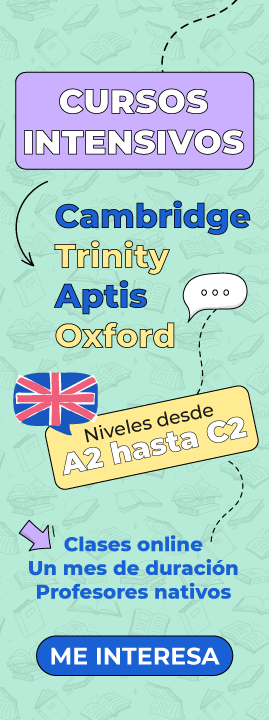The strangest methods of learning a foreign language

The strangest methods of learning a foreign language
ÍNDICE DE CONTENIDOS
Everyone knows that what is strange to one, to another, may be unusual or innovative, and to a third, it will be “great.” So the title of this article cannot be strictly judged. The different versions to study a language that we expose here, although it may seem strange to many people, has given it a satisfactory and even extraordinary result.
Therefore, we will get to the point. In these pages we will tell you about the many classic ways of learning English (and any other language).
Crazy English
The story is this: Around the 1990s, a Chinese engineer named Li Yang had the ability to excel in English, and he quickly realized that not everyone has his luck. Later, Young copied his way of studying and with his experience he addressed the public. Since then, he is said to have earned millions of dollars and, according to himself, has taught more than 20 million people English.
What is the essence of his method: He simply says that by shouting out loud, you learn: this is the motto of the technique . For Young, the foundation of success in this life is from the heart and with total dedication, therefore the fact of the matter is that new words and phrases in English should be… shouted. That easy. Here’s what it looks like: fast-paced students shout popular or random English phrases, accompanying them with gestures. In the classroom, a minimum of grammar, reading, listening and little else.
- Why can they work? : Chinese youth, who from childhood were raised in the spirit of ” shut up and respect your elders “, ” take care of your face “, etc., face the fear of mistakes, the embarrassment of accent and insecurity, and take their first steps in English.
- Why is it better than conventional? Well, the truth is that educators in China are so active in protesting this approach that the administration has banned it in some regions. Teachers of the “old school” are outraged that Young does not instill in the classroom a systemic understanding of language, its internal structure. This is where the roots of “Chinese-English” grow.
Phonetic associations
The question is where did it come from? The method of phonetic (sound) associations was created by Stanford University professor Ron Atkinson and later tested quite successfully among his students.
What is the key? : Many languages have similar sounding words. Naturally, where the meaning is the same, there are no difficulties. And when the meaning differs, it is then necessary to find associative phrases that are easier to remember than “just words” out of context. For example, the word “onion” will help you remember the word look: I can’t look when I cut the onion. Or mesh: the tie prevents you from going out.
Why can it work or rather why has it worked? : Evolutionarily, the human brain is “sharpened” on history, inventing it, retelling it, memorizing it (from the days of primitive gatherings around the fire). So it is actually easier for us to remember a phrase than to memorize a single word.
But why unconventional: this is just a technique for memorizing words, a small part of the whole system called “learning a foreign language”. You cannot learn grammar, syntax, etc. with associations.
Total immersion (personality change)
Where did it come from ?: The method was invented by a German , and then by the American linguist and professor Maximilian Berlitz in the 19th century.
What is the essence? Students perform a role play without empty words. In the classroom (and preferably outside of them), they should forget their old identity (name, age, profession, etc.) but instead propose a new one in the language they are learning. And now the engineer Vanya from Astrakhan becomes the taxi driver Jonathan, who lives in New York. And of course, no prompts or speaking in your native language during class!
Why can it work? : “Immersion” and / or the artificial creation of a linguistic environment for oneself is recognized by the world pedagogical community as very useful for learning a foreign language.
Why Unconventional: The method clearly cannot initially be aimed at beginners. Otherwise, he would have to play deaf-mute Peter from Kansas. And there are also many questions about the problem of building a language system in the head.
NLP method
Where he came from? : NLP was invented to be able to influence a person at a subconscious level, helping them to become what they want: more determined, courageous, enterprising, confident, etc. Over time, the hypothesis emerged organically that it was possible to teach not only personality characteristics, but also skills.
What is the essence? : The English teacher combines classical lessons with popular NLP techniques such as anchoring, swish, reframing and others.
Why it works: The correct use of the principles and techniques of NLP helps to develop self-confidence, also to overcome the fear of speaking and tune into productive learning.
Why unconventional? : not everyone respects NLP. It is questioned because the effectiveness of the method has not been proven. The results are difficult to evaluate and measure; are they related to the use of NLP, or the “classical” teaching methods worked well.
Physical response (silent method)
Where he came from? : The method was proposed by James Asher of the University of San José in the 70s of the last century.
What is the point? : It will seem strange, but children learn the language in silence. First, they listen for a long time and absorb new words, intuitively guessing their meaning. They then learn to understand the action verbs and to act on them (“hit the ball”, “come here”). And only after the development of a spontaneous physical reaction to the processes taking place around, the child will dare to speak. Asher suggested teaching adults a second language in the same way that children learn the first.
Why unconventional? : Well, simply, because “passive” listening can take a couple of years (many children start talking at 2 years old). Most adult learners are not willing to wait that long (and pay for classes!).
Table 25
Where it came from? Entrepreneur James Vicari suggested the hypothesis that a person can be inspired by a wish or a thought if you let them see certain images. The suggestion will not cause protest if the image is placed in frame 25, which the person supposedly cannot consciously see and perceive. The vicars made a lot of money from the hype, and their followers developed the box 25 theory and suggested that it can not only be inspired, but should also be taught.
What is the point? At one point, a certain “25th frame” program was roaming the web, and at a rapid pace it was flipping word cards across the screen. The creators argued that it is not necessary to memorize anything, just look and the subconscious mind will “remember” itself. Here are just the rate of change of frames (several per minute) in any normal person will provoke the desire to turn off the program and not selflessly “learn”.
Why can it work? : It can’t! The reliability of the table 25 theory was confirmed by only one study, and it was conducted… by James Vicari. Well, you get the idea.
Why unconventional? : who believed and was burned does not repeat. But the legend lives on, because everyone loves “magic pills.”
Emotional drawing
Where he came from? We can’t find the sources. But we suspect that life itself suggested the idea.
What is the point? Students draw bright, expressive pictures and sign them in the target language. It is important to think about what you are drawing.
Why can it work? : visual and kinesthetic memory is involved (and among people up to 80% are visual). Also, the method can not be called boring, but the interesting thing is easier to remember.
Why unconventional? : the method is ideal for children. Adults will see many shortcomings in him, from industriousness and “time consuming” to limitation, because only words are studied in this way, and extremely concrete ones.
Theatrical method
Where he came from? Learning from your favorite activities is so common that you can’t find the roots. It was thought that the theater as a “base” should be taken as the base in the MESS theater studio in Moscow.
What is the point? Students learn English while performing a real theatrical musical, in English only. All rehearsals are in English, costume designers, makeup artists and stage directors also try to communicate in English (as much as possible).
Why could it work? : the method is similar to immersion. It works the same way.
Why unconventional : not suitable for beginners. Also those who are afraid of the stage. And the scope is limited.
Hypnopedia (sleep learning)
Where it came from : Buddhist monks and Indian fakirs have tried to use sleep for learning since ancient times. The method received a new round of popularity in the 20s of the last century.
What is the point? : During natural sleep, students listen to recordings of words, phrases, dialogues, texts. And when they wake up, they are able to reproduce them. Or at least memorize “consciously” much faster.
Why can it work? In fact, scientists have not yet agreed on the effectiveness of the method, but there are many more studies with the conclusion that it does not work.
Why unconventional? : Even those researchers who are “in favor” of the method admit that the brain is capable of assimilating information in a dream, but not of building connections. But it sounds so beautiful that literature and cinema have picked up: elements of hypnopedia that we find in the novels “Brave New World” by Huxley, “Ugly Swans” by Strugatsky, in the television series “Big Change”, “The Simpsons “And even in the cartoon” Barboskins. ”
Hypnosis ( not to be confused with hypnopedia!)
Where he came from? : That just with the help of hypnosis they didn’t try to do! Learning a foreign language is far from the most exotic.
What is the point? : the hypnotherapist acts as a teacher himself or works together with the teacher. Hypnosis sessions and classical language learning techniques alternate. Proponents of the method see the benefit of using hypnosis in the fact that it introduces a person into a state of over learning and concentration, in addition (similar to NLP) it eliminates fears, clamps and blocks. By the way, a third element can also be added to the training: psychotherapy, when, for the sake of successfully learning a foreign language, a specialist works with a student on his childhood trauma, adult phobias, etc.
Why does it work? Hypnosis, unlike skeptics, is an applied science and is quite effective when it comes to highly suggestible students.
Finally, we want to remind you that if you want to obtain an official degree in any language, you should check the number 1 online platform.



